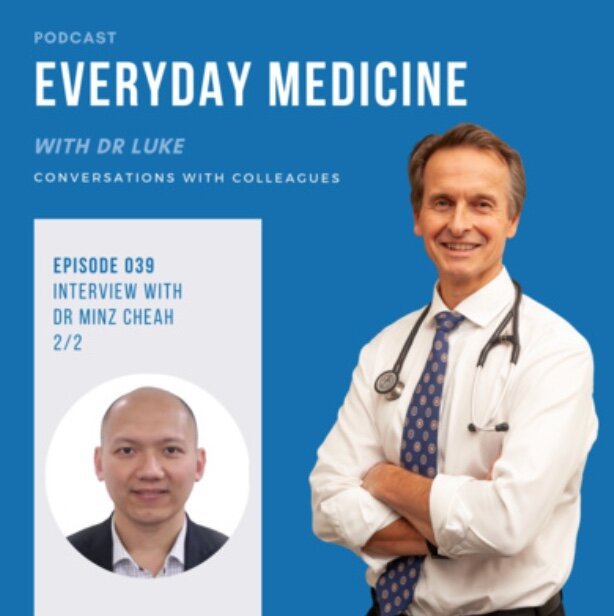Everyday Medicine by Dr Luke Crantock
Conversations with colleagues providing helpful ideas and advice in healthcare
Episode 49. IBS with Dr Catherine Sorrell
Irritable bowel syndrome is an idiopathic clinical entity characterised by chronic (more than six months) abdominal pain that occurs in association with altered bowel habits. In 2016 the Rome IV Consensus report adjusted the diagnosis to include symptoms occurring at least once a week from a previous definition of three times a month and include the notation of abdominal pain rather than discomfort related to defaecation. In practical terms, irritable bowel syndrome is in part a diagnosis of exclusion, however, in younger patients without alarm symptoms a simple stool test for calprotectin rather than extensive endoscopic work up may be all that is required. A negative calprotectin favouring conservative and symptomatic management, a positive finding requiring further workup.
Episode 48. Eosinophilic Oesophagitis with Dr Darcy Holt
Now recognised as one of the most common conditions underlying food impaction events, eosinophilic oesophagitis (EOE) has an estimated prevalence of 0.4% among both children and adults. EOE is a chronic inflammatory disorder characterised by oesophageal dysfunction and eosinophil predominant inflammation. Relatively recently described we may speculate as to whether this is a truly new disease or a more recently recognised one.
Special Episode 6. Mental Health in a time of Covid (and the polyvagal ladder) with Brenda Sutherland
Mental health has become a major casualty of the Covid pandemic that has swept across the globe and been responsible for rolling lockdowns throughout Australia restricting personal freedoms, social contact and the ability to prosper financially. No one is exempt from this unprecedented event and the anxiety, depression and anguish wrought is having a major effect on the health and wellbeing of our communities.
Episode 47. Helicobacter Pylori with Dr Darcy Holt
Helicobacter pylori is a gram-negative curved bacillus that may colonise the gastric and proximal duodenal mucosa. Its significance was first described by Barry Marshall and Robin Warren in 1982 both of whom were awarded the Nobel prize in 2005 after the Nobel community described the discovery as the most impacting in medical sciences. Most medical practitioners are aware of the pathophysiological consequences of Helicobacter which is responsible for gastritis, gastric and duodenal ulcer disease, and may be associated with gastric adenocarcinoma as well as mucosa associated lymphoid tissue hyperplasia (MALT lymphoma). Its eradication has largely hinged on standard triple therapy including a PPI combined with amoxicillin and clarithromycin taken together for 1 week in Australia; unfortunately this regimen has a 10-15% failure rate.
Special Episode 5. Psilocybin assisted psychotherapy with Dr Margaret Ross
The burden of mental health to Western society ranks amongst the leading causes of overall clinical presentations and the impact of anxiety, depression, addiction, substance abuse and PTSD can be devastating both to individuals and society. Recognition that psychedelic therapies may offer a profound benefit in the treatment of these conditions has rekindled a renaissance in their use, in particular of psilocybin from Psilocybe cubensis or “magic” mushrooms. The Australian Psilocybin Assisted Psychotherapy study at St Vincent’s focusing on end of life anxiety and depression is providing fascinating insights into the place and future use of these compounds.
Episode 46. Obstructive Sleep Apnea with Dr Michael Ho
Obstructive sleep apnoea is common, it is estimated that 49% of men aged 40-69 have obstructive sleep apnoea rising to 62% above the age of 70. Up to 1 in 10 have undiagnosed obstructive sleep apnoea which may present with snoring, daytime somnolence, depression and significant hypoxemia during sleep with associated cardiac arrhythmias.
Episode 44. Thyroid Nodules with Mr Cyril Tsan
Thyroid nodules are common, in some ultrasound series at least 30% of adults are found to have nodules and 4-7% of adults will have a palpable nodule. Whilst the overall risk of malignancy within a nodule is less than 5%, this is dependent on thyroid imaging reporting and data system (TI-RADS) which reflects features such as size of the nodule, presence of microcalcification, cyst complexity, whether the cyst is taller than wider and the presence of intranodular vascular images.
Episode 43. Radiofrequency Ablation with Dr Matthew Swale
Radiofrequency ablation (RFA) has revolutionised treatment for tachyarrhythmias and has become first line treatment for some tachycardias. Some arrhythmias are relatively common, atrial fibrillation for example affects up to 9% of our population over the age of 80 years and provides a very significant risk for thromboembolic stroke, haemorrhagic stroke as well as impairment of quality of life whilst also contributing to heart failure.
Episode 41. Secondary Prevention of Cardiovascular Disease with Dr John Counsell (Part 2)
Heart disease affects one in six Australians with an AMI occurring every 10 minutes and accounts for one in four of all deaths, so primary and secondary prevention are very important considerations in relation to any patient presenting with heart disease or at risk of heart disease. Risk factors including family history, lipid abnormalities, diabetes mellitus, hypertension, smoking or those with elevated BMI all need consideration. Whilst there have been significant controversies regarding lipids management and the use of statins, the evidence for their use, particularly in secondary prevention of heart disease is clear.
Episode 39. Muscle Joints Aches and Pains with Dr Minz Cheah
Based on the Australian Bureau of Statistics National Health Survey data about one in three people over the age of 18 living in Australia have hypertension or were taking blood pressure lowering medications. A staggering number requiring therapy for a condition which impacts on cerebrovascular disease, coronary artery disease, chronic kidney disease, heart failure and mortality.
Episode 38. Hypertension with Dr Minz Che
Based on the Australian Bureau of Statistics National Health Survey data about one in three people over the age of 18 living in Australia have hypertension or were taking blood pressure lowering medications. A staggering number requiring therapy for a condition which impacts on cerebrovascular disease, coronary artery disease, chronic kidney disease, heart failure and mortality.
Episode 37. Why We Get Fat And What We Can Do About It with Professor Joseph Proietto
The western world faces a very significant obesity epidemic. In Australia, two-thirds of our population or 12.5 million are either overweight or obese and as a consequence may experience many medical sequelae including development of the metabolic syndrome, type 2 diabetes, cardiovascular disease, cerebrovascular disease, osteoarthritis and depression, contributing significantly to our health burden. In the first part of this series, we were joined by Joseph Proietto, Professor Emeritus at the University of Melbourne, the Department of Medicine at Austin Health and an endocrinologist specialising in diabetes and obesity to discuss why we become obese. Professor Proietto joins us again to guide us through a strategy of how to treat and manage obesity and direct our patients toward a healthy body mass index (BMI).
Episode 35. The spleen and postsplenectomy syndrome with Dr Mohammed Al Souffi
The spleen performs a large number of important functions including processing and removal of opsonized pathogens, cellular maintenance, immunoglobulin production and the removal of effete worn out red blood cell. When removed either through trauma or for therapeutic indications the risk of overwhelming post splenectomy infection (OPSI) increases significantly; up to 58 times the general population in the setting of trauma and up to 1,100 times increased risk when for thalassaemia.
Episode 33. New Advances in Cardiology with Dr James Sapontis
We are joined today by Dr James Sapontis, head of complex coronary intervention at Monash Heart and formerly trained through Mahi Missouri and Kings College London to discuss new advances in the field of cardiology.
Episode 32. Lung Cancer with Mr Cliff Choong
Lung cancer is a major problem facing Australian doctors representing 9% of all cancer diagnoses and with 12,200 new cases of lung cancer diagnosed each year it is the fifth most commonly diagnosed cancer, but the most common cause of cancer death in this country for both men and for women. The early presentation of lung cancer may be as subtle as a small coin lesion or nodule seen on chest imaging and there are a multitude of ways in which such nodules may be interrogated further. Whilst a wait and watch approach may be appropriate, further evaluation by VATS with a tissue diagnosis maybe required.















